Key takeaways:
- Effective communication involves emotional and intellectual connection, emphasizing the importance of active listening and tailored messages to engage the audience.
- Clear storytelling in advocacy can transform discussions and foster emotional connections, making the communication of human experiences vital for rallying support.
- Building trust within communities relies on genuine listening, consistent presence, and transparency about challenges, encouraging open dialogue and connections.
- Organizing local events and utilizing social media can enhance outreach, bringing communities together for meaningful interactions that inspire change through shared personal stories.
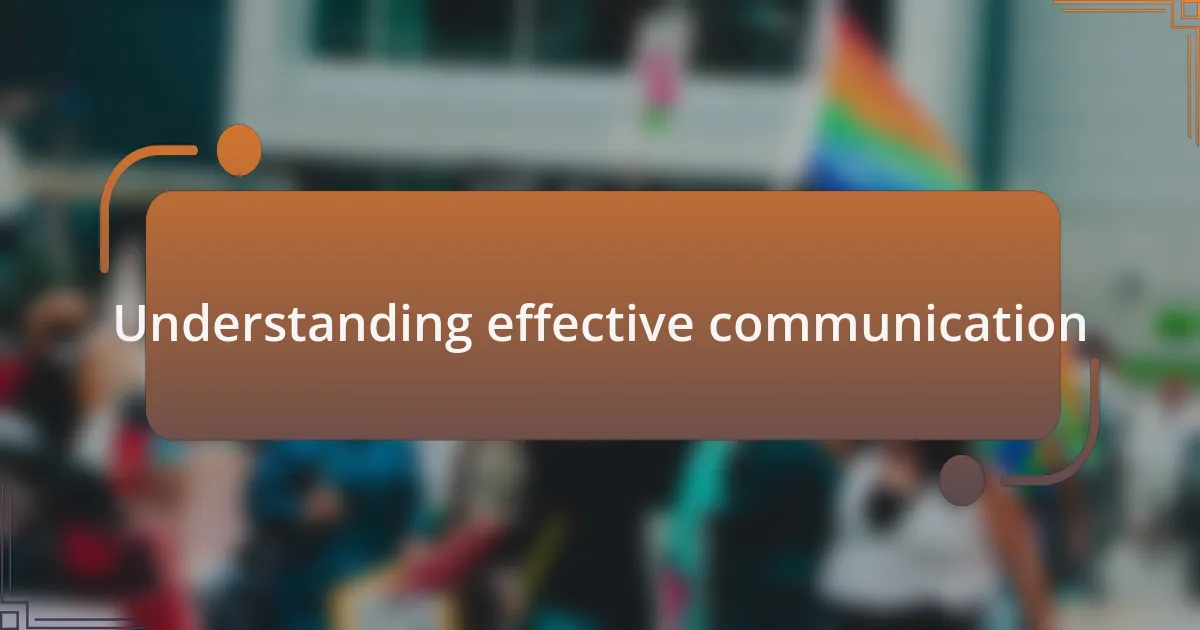
Understanding effective communication
Effective communication is more than just exchanging words; it’s an art of connecting emotionally and intellectually. I remember a time when I hosted a community discussion on pro-life advocacy. Instead of delivering a lecture, I opened the floor for sharing personal stories, allowing others to voice their experiences. It was amazing how much power intimate dialogue can hold in fostering understanding.
When we consider our audience, it’s crucial to ask ourselves what resonates with them. Have you ever been in a conversation where the other person didn’t seem to understand your perspective? That frustration is often due to a lack of empathy or consideration for the listener’s background. Tailoring our messages to connect with the values and feelings of our audience can transform a dialogue into a meaningful interaction.
Engaging others through active listening is another vital aspect of effective communication. I’ve found that when I genuinely listen to someone, I can gauge their emotions and thoughts, allowing for a more heartfelt response. Isn’t it fascinating how a simple nod or reflective question can invite someone to share even deeper feelings? This two-way approach not only cultivates trust but also encourages open discussions about sensitive topics.
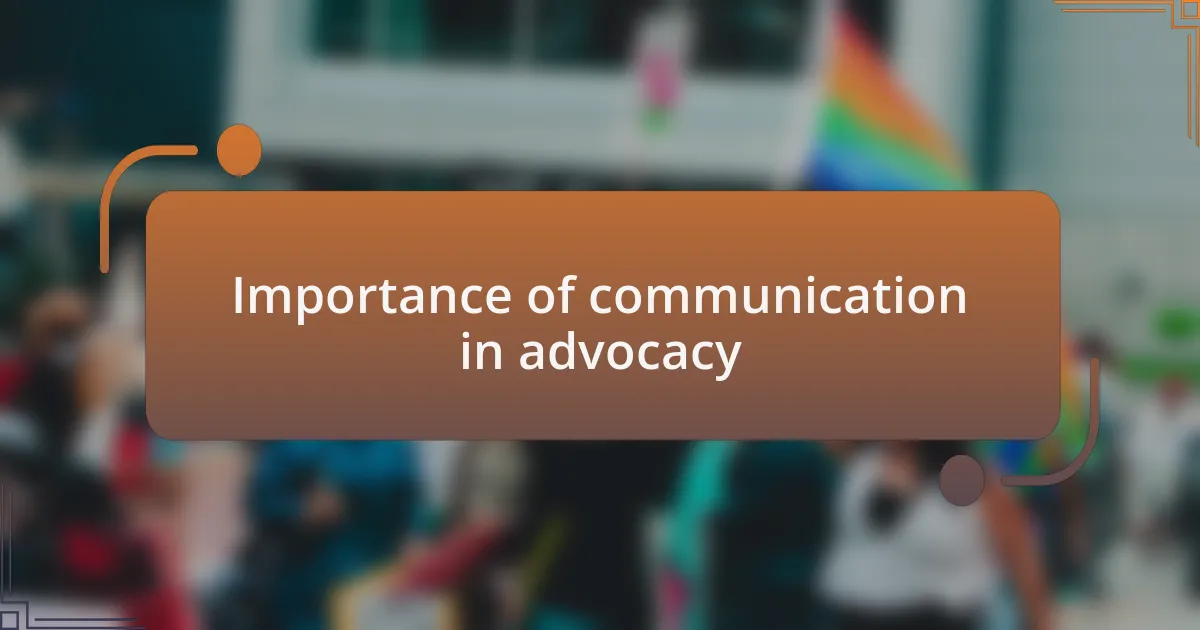
Importance of communication in advocacy
The strength of communication in advocacy cannot be overstated; it’s the lifeblood of any movement. I’ve learned that sharing clear and compelling messages can rally communities together. Once, during a rally, I witnessed how a simple story about a mother’s journey transformed the atmosphere, igniting passion and urgency in the crowd. It made me realize how vital it is to communicate not just facts, but also the human experiences that underpin our cause.
When advocating for pro-life issues, striking the right tone is essential. I remember a time when I framed a discussion around the joy of life, focusing on hope rather than fear. The shift in energy was palpable—people connected emotionally, leading to more meaningful dialogue. Have you ever considered how the words we choose impact not just the message but the emotions behind it? I see it repeatedly; language shapes perception and can either create barriers or build bridges.
Building relationships through open communication is equally important. In my experience, I’ve found that genuine conversations over coffee can yield insights that formal meetings often miss. It’s in those relaxed environments that people feel safe to express their thoughts openly, deepening our collective understanding. Isn’t it fascinating how trust develops when we share not just our views, but our vulnerabilities? This approach not only strengthens our advocacy work but also fosters a sense of community that is hard to replicate.
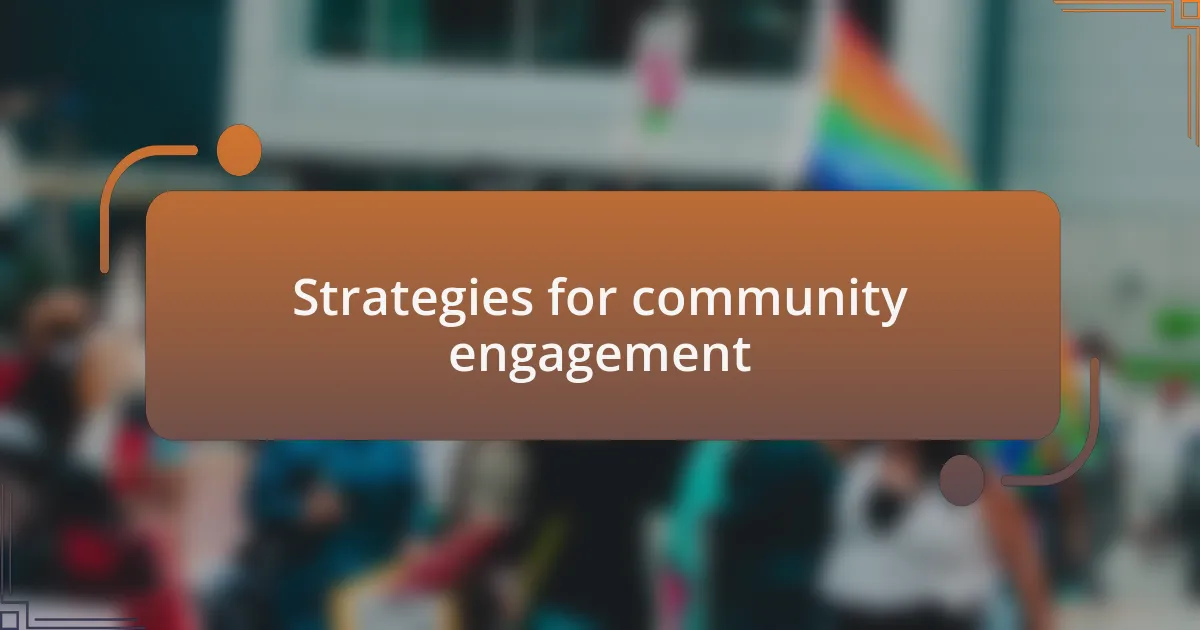
Strategies for community engagement
Engaging with the community requires meaningful interaction, and one effective strategy I’ve employed is organizing local events that invite open dialogue. I recall hosting a community picnic where families came together not just to enjoy food, but to share their thoughts and experiences regarding pro-life issues. The relaxed atmosphere fostered connections that led to deeper conversations. Have you ever experienced how much people are willing to share when they’re comfortable?
Another approach I find valuable is using social media platforms to reach a broader audience while maintaining a personal touch. I once started a weekly “Story Spotlight,” showcasing local individuals who have positively impacted the pro-life movement. Each story sparked conversations and encouraged others to share their own journeys. Isn’t it remarkable how a single story can inspire a ripple effect within the community?
Finally, I believe in the power of collaboration with local organizations to amplify our message. Partnering with community groups not only broadens our reach but builds greater trust. I experienced this firsthand when collaborating with a local charity; it brought a diverse group of people together. Together, we created a safe space where dialogue flourished. Have you ever thought about how partnerships can enhance the effectiveness of our advocacy efforts?
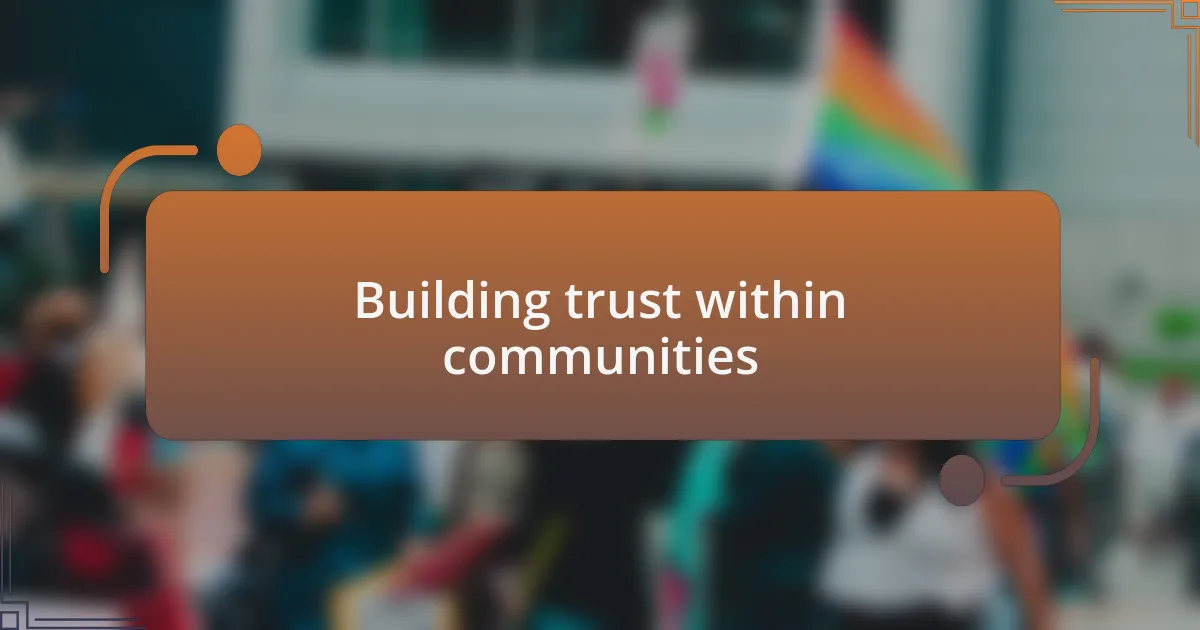
Building trust within communities
Establishing trust within communities starts with genuine listening. I recall sitting in a small circle at a community center, where I simply listened to mothers share their experiences with pregnancy and support systems. Their vulnerability opened my eyes to the unique challenges they faced, and I could feel the weight lift as they realized someone was truly hearing them. Have you ever felt the relief that comes from being understood?
Another key element is consistency. In my journey, I’ve learned that showing up reliably—whether at community meetings or social events—cements credibility. One summer, I committed to attending monthly neighborhood forums, rain or shine. I noticed how my consistent presence encouraged others to engage, ultimately leading to a space where trust was mutual. Isn’t it fascinating how showing up can build connections over time?
Lastly, transparency is vital. I once launched a campaign aiming to raise awareness about local resources for pregnant women but was upfront about the challenges we faced. By sharing both our successes and setbacks, I noticed that community members responded more positively. It seems that when we are honest about our journey, it invites others to share theirs. How do you think openness can change the dynamic in community discussions?
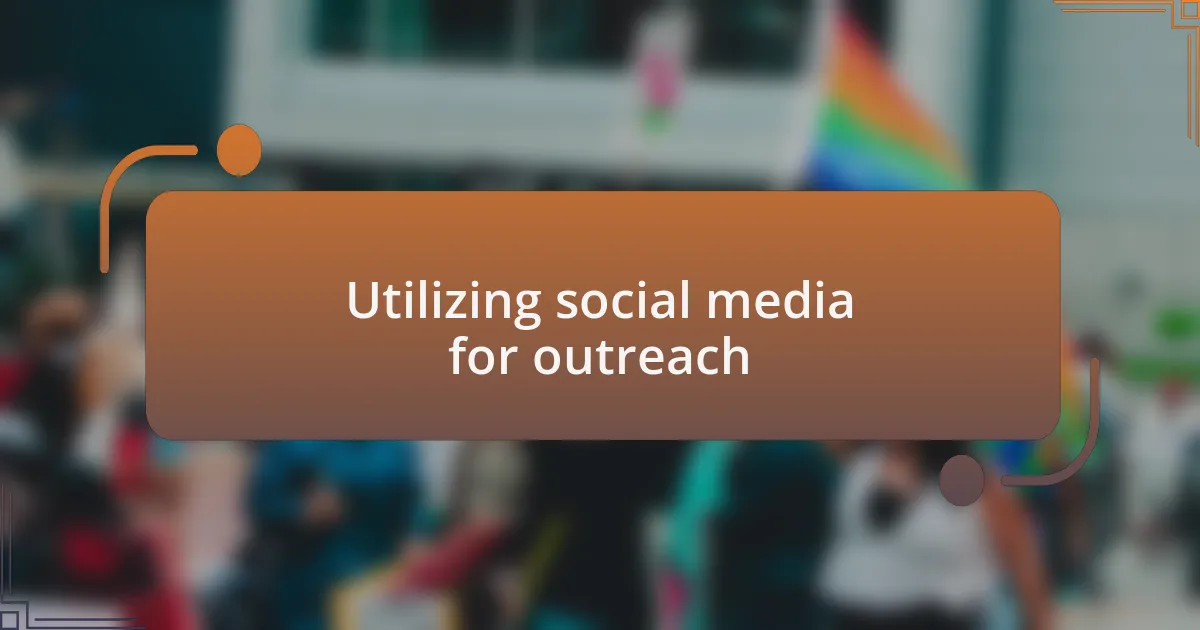
Utilizing social media for outreach
Social media serves as a powerful tool for outreach within communities. I remember the first time I created a Facebook group dedicated to pro-life advocacy in my area. It felt exciting to see how a single post could spark conversations, unite diverse voices, and even connect individuals who had previously felt isolated. Have you ever witnessed a simple online post create waves of support in your community?
Engagement is key when utilizing social media. One approach that worked for me was hosting live Q&A sessions on Instagram, where I shared my thoughts and experiences related to my advocacy. The real-time interaction fostered a sense of belonging and encouraged followers to share their stories too. I learned that people crave connection and engagement, and providing a platform for dialogue can lead to unexpected alliances. Isn’t it amazing how a conversation, even digital, can bring people together?
Visual storytelling can also enhance outreach efforts. I started posting personal stories accompanied by images—whether it was snapshots of community events or moments of connection with families. The visual aspect seemed to resonate deeply; I noticed an uptick in shares and comments. It really hit home for me when a mother reached out, saying that seeing our journey inspired her to seek support for herself. How powerful is it to know that our shared experiences can motivate and uplift others?

Organizing local events for impact
Organizing local events can be a game-changer for pro-life advocacy, and I’ve seen firsthand how a well-planned gathering can amplify our message. I recall a community picnic we hosted to discuss our stance on pro-life issues. It was incredible to see families come together, not just to eat and socialize, but to engage in meaningful conversations about life and the resources available for expecting parents. Have you ever felt the warmth of community spirit at such an event? It’s truly inspiring.
One of the most impactful events I was involved in was a candlelight vigil for life. We invited people to share their stories, which created an intimate atmosphere that encouraged vulnerability and sharing. I still remember one woman openly discussing her past decisions and how she’s found healing. This openness fostered a supportive environment that not only educated attendees but also solidified bonds within our community. Isn’t it extraordinary how sharing personal journeys can spark healing and solidarity?
Additionally, collaborating with local organizations to host joint events enhances our reach and impact. For instance, partnering with a local maternity home to create a family-friendly day brought together diverse groups who might not typically engage with pro-life topics. The laughter of children, the joy of crafts, and the chance for adults to connect and learn created a space where advocacy felt both approachable and necessary. I believe events like these illustrate a fundamental truth: effective communication occurs best in environments where community members feel welcomed and valued.
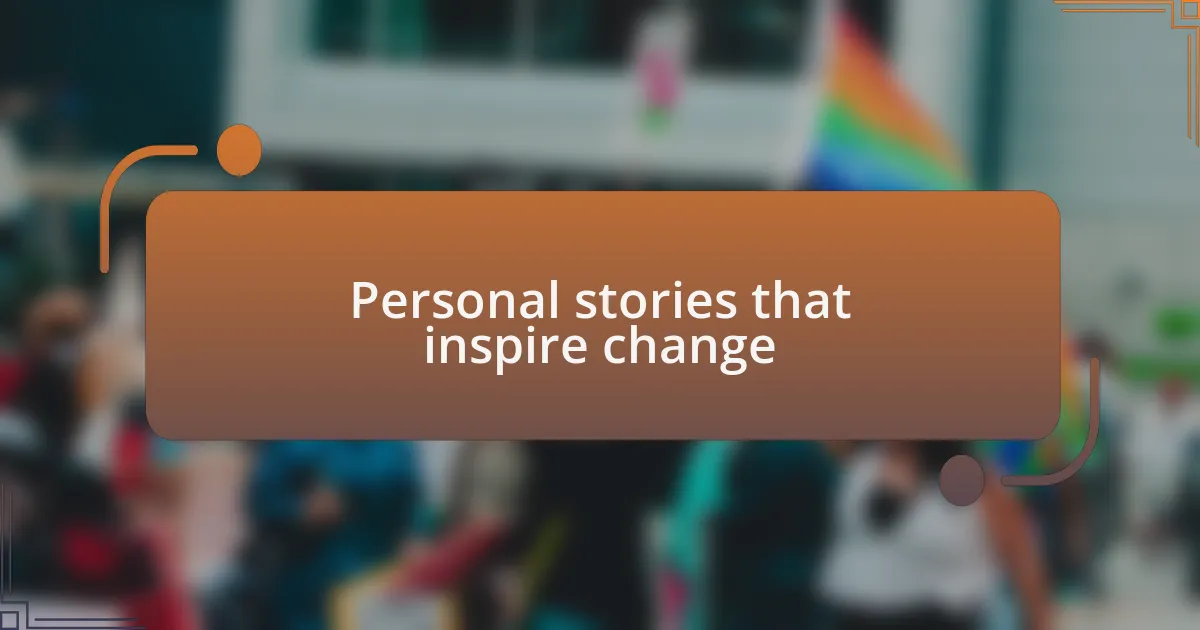
Personal stories that inspire change
Personal stories can be profound catalysts for change, often revealing the real impact of pro-life advocacy on individual lives. One evening, I sat in a small circle during a community meeting, listening to a young father share his journey of unexpected fatherhood. His voice quivered as he spoke about the fears he faced, but what struck me most was his transformation into a passionate advocate for life. Can you imagine the courage it takes to shift from uncertainty to becoming a voice of hope?
I remember a brave woman named Sarah who stood up at one of our gatherings, articulating her experience with a crisis pregnancy. The vulnerability in her words resonated throughout the room; many attendees were visibly moved. I couldn’t help but think how her bravery not only inspired others to share their stories but also sparked a dialogue about the resources available to those in similar situations. Isn’t it remarkable how one story can break down walls and create a pathway for healing and understanding?
Moreover, I once witnessed a group of high school students participate in a panel discussion about their beliefs on life. Their raw honesty about the challenges and victories they faced while supporting friends in difficult situations was an eye-opener. Listening to their perspectives reminded me that when young voices share their insights, it can profoundly impact how we view advocacy and community support. How often do we overlook the power of youth in shaping our conversations about life? Their stories illuminated the importance of nurturing an environment where all voices are heard and valued.